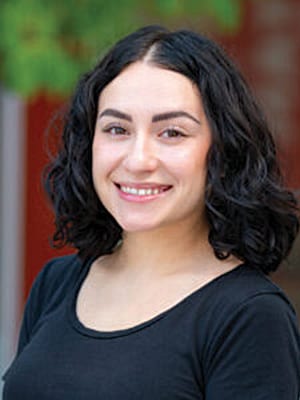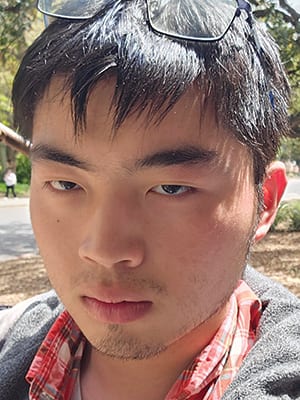The ‘Emerging professionals’ issue
bulletin | emerging professionals

Future Focus articles
DEI at ACerS
The American Ceramic Society values and seeks diverse and inclusive participation within the field of ceramic science and engineering. Learn more about how you can foster diversity, inclusivity, and equity in the sciences on the ACerS “Fostering equity in science” resource page.
More inclusive Q&A sessions will lead to more learning
By Chris Rom
Conference presentations and academic seminars are a key way to share ideas across institutions and build networks with other researchers. However, the question and answer (Q&A) sessions that follow are not fully inclusive: Women ask fewer questions than their share of the audience.1
This finding comes from a study led by Alecia Carter, professor in evolutionary anthropology at University College London. Her team collected data from 247 academic seminars across biology and psychology departments in 10 different countries, counting the men and women in the audience and tallying the questions asked by each group. They found that, on average, women composed 51% of the audiences but asked only 32% of the questions.
Frustrated by the inequity their work revealed, I wondered: Does this problem happen in my communities of ceramics and solid-state chemistry? I replicated their methods at the public talks I attended during my graduate and postdoc studies.* Figure 1 shows that this imbalance also affects my communities, including at a recent ACerS conference.
READ MORE
Q&A sessions provide the benefits of additional learning and enhanced visibility for audience members who ask questions, but women are missing out on these benefits. As a community, we also miss out on the thought-provoking questions that would be asked if Q&A sessions were fully inclusive.
We can and should do better, but how? Raising awareness helps. In 2015, Stanford University graduate student Natalie Telis and colleagues noticed a huge imbalance in the Q&A sessions at the genetics conference they were attending.2 They discussed the issue on Twitter, which led to a mid-conference presentation on the problem along with a rule change: The first question after each talk must come from a student. Subsequent Q&A sessions at that conference were nearly, though not quite, gender balanced.
Another approach is to pause between the talk and Q&A session so audience members can discuss amongst themselves. Carter et al. suggested that this strategy may help by “[giving] people time to formulate a question and try it out on a colleague.”1 However, evidence on the classroom equivalent of this Q&A strategy (the think-pair-share pedagogical technique) suggests it may not lead to more inclusive public Q&A.3
A third option is to enable audience members to ask questions anonymously to remove the pressure of off-the-cuff public speaking. Various online platforms exist to anonymously solicit questions via a QR code, such as Slido and Google forms. But this approach comes at the cost of visibility for those who ask questions.
Despite the tradeoffs with each method, I believe they are better options than the status quo. We should experiment and assess how effective these and other strategies are at encouraging participation from all types of people. If we improve the format of Q&A sessions, we will become more effective at learning from each other and solving big challenges.
References
1 Carter AJ, Croft A, Lukas D, Sandstrom GM. “Women’s visibility in academic seminars: Women ask fewer questions than men,” PLOS ONE 2018, 13(9): e0202743.
2 Telis N, Glassberg EC, Pritchard JK, Gunter C. “Public Discussion Affects Question Asking at Academic Conferences,” The American Journal of Human Genetics 2019, 105(1): 189–197.
3 Cooper KM, Schinske JN, Tanner KD. “Reconsidering the Share of a Think–Pair–Share: Emerging Limitations, Alternatives, and Opportunities for Research,” LSE 2021, 20(1): fe1.
About the author
Chris Rom is a postdoctoral researcher at the National Renewable Energy Laboratory, where he works on new materials for semiconductors, batteries, and magnets. Contact Rom.
*I did not count nonbinary attendees or question-askers to protect their privacy, as small datasets risk being identifiable (ethical approval CSU IRB #3835).
Figure 1. Percentage of women in the audience versus the percentage of questions from women (n = 133 Q&A sessions). Data were collected at in-person conference presentations and academic seminars attended by the author between 2018 and 2024.
Credit: Chris Rom

COLLAPSE ARTICLE ABOVE
ACerS Global Graduate Research Network
ACerS Global Graduate Researcher Network (GGRN) membership addresses the professional and career development needs of graduate-level research students who have a primary interest in ceramics and glass. Learn more.
Celebrating underrepresented students with the CGIF’s Underrepresented Student Scholarship Fund
By Helen Widman
The Underrepresented Student Scholarship Fund, a program sponsored by the Ceramic and Glass Industry Foundation (CGIF) and ACerS, serves to support underrepresented undergraduate students studying materials science. The CGIF partners with the National Society of Black Engineers (NSBE) and the Society for Hispanic Professional Engineers (SHPE) on this annual scholarship.
In 2023, the CGIF awarded three students with the scholarship: Megan Bynoe (NSBE), Alejandra Almaraz (SHPE), and Fernanda Garcia (SHPE). Learn more about each student’s research and goals in the bios on this page.

Fernanda Garcia, SHPE

Alejandra Almaraz, SHPE

Megan Bynoe, NSBE
Help the CGIF support underrepresented students in materials science by contributing to the Underrepresented Student Scholarship Fund.
READ MORE
Megan Bynoe
Bynoe is a fourth-year undergraduate student in materials science and engineering at Rutgers, The State University of New Jersey. The goal of her research is to create 3D-printed ceramics for aerospace applications, and her dream role after graduation in 2024 involves continuing to work in the aerospace industry. She is also an ambassador for the Rutgers School of Engineering, where she gives tours to prospective engineering students and emphasizes the importance of diversity in the engineering field.
“I think the beauty of bringing in diversity is that you’re always going to have different diversity of thought with that, too. I think that is really important because that’s how you can move on, that’s how you can be challenged, that’s how new ideas come about.”
– Megan Bynoe
Alejandra Almaraz, SHPE
Almaraz is president of SHPE at Boise State University in Idaho, where she studies materials science and engineering. She uses aerosol jet printing to deposit nanoparticle-based inks consisting of titanium carbide MXenes. She hopes to one day use her research to combine materials science with biomedical applications while also encouraging women and Hispanic youth to pursue careers in STEM. She also serves as an officer of the Society of Women Engineers.
“I just think it is super important to have all the different perspectives and for young minds to be able to see that people of color and women are welcome in fields that are traditionally white male dominated.”
– Alejandra Almaraz
Fernanda Garcia, SHPE
Garcia is a materials science and engineering student at California Polytechnic State University. She conducted her senior project on batteries and polymers and knows that she wants her future career in materials science to provide opportunities for giving back to young women in STEM. She feels passionate about supporting migrant students in STEM through her volunteer efforts, such as at Girls in Engineering Camp, Baskin Girls in Engineering Camp, and The Mary Louise Academy Summerfest engineering camp in New York, among others.
“Support comes in so many different shapes. Something that I encourage a lot of women to do is to get into science and to try it out and see if that’s for them. There are a lot of females who are inside, who feel lonely, and would love to have more females. We’re here to help. And for those who are already in STEM, I would say to just keep going: We’re almost there.”
– Fernanda Garcia
COLLAPSE ARTICLE ABOVE
ACerS Young Professionals Network
ACerS Young Professionals Network (YPN) aims to provide support, community, and leadership opportunities to members as they transition from students to successful professionals in the broader ceramics society. Learn more.

INCLUSIVITY, DIVERSITY, AND ETHICS IN RESEARCH
Alloying my love of pottery with my love of materials science
By Alex I. Tam
Growing up, my father drilled into me that “the hard work of today is the success of tomorrow.” Rather poetically, this mantra is reflected in my Chinese name, which contains the character for “complete.”
As a child, I would grip my pencil so tightly while completing assignments that it left indents in my hand. Outside of school, I worked in my maternal grandmother’s antique shop, helping sell porcelain pillows, antiques, and clay idols.
This job gave me an interest in art, and in both middle school and college, I spent time working on pottery and porcelain at the town’s craft center. During that time, I experimented briefly with crazing, which involves choosing glazes with different thermal expansion coefficients than the base ceramic so a web of tiny cracks will appear and cover the final surface.
READ MORE
This love of pottery and crazing, in addition to my interest in studying the Japanese language, led to my discovery of the Japanese artform of kintsugi. In contrast to crazing, which only introduces small line fractures into the glaze, kintsugi involves breaking the entire ceramic vessel and then joining the pieces back together using lacquer and gold. The repaired ceramic gives the effect of permanent evanescence because the breaking of a singular moment is captured in all eternity.
This idea that something can be complete “because of” rather than “despite” the cracks is echoed in my undergraduate studies in materials science. Engineering of grain boundaries is a major tool in the design of ceramics and composite materials. By deliberately introducing cracks into a ceramic’s microstructures, it can halt the transmission of defects while increasing the material’s strength.
These lessons from pottery and materials science about “completeness” changed my understanding of the concept. Like everyone, I am not without my internal contradictions. But these flaws play a role in bolstering my character and integrity.
In addition, my memories working in the antique shop and listening to my father’s and grandparents’ stories help me cherish my current opportunities: my grandparents never went to university as I am doing now. So, through my internal flaws and bonds with others, I can learn to improve myself, thus living up to my “complete” name.
About the author
Alex I. Tam is a third-year undergraduate student at the University of California, Davis, working with professor Subhash H. Risbud on the characterization of novel superconductors and professor Mingwei Zhang on the characterization of novel high-entropy alloys. His hobbies include studying other languages, reading history books, and experimenting with porcelain.



